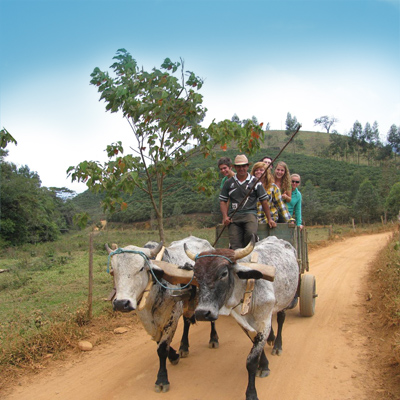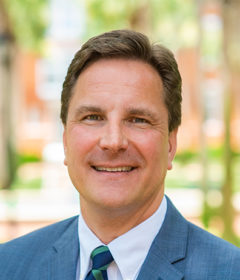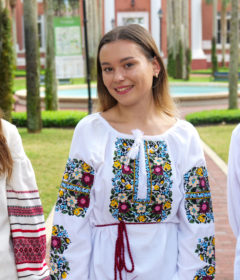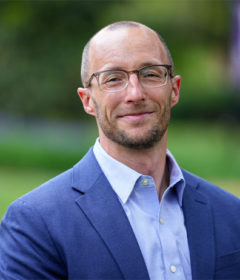Into the Mountains and Valleys of Brazil

The Latin American Studies Mentored Field Experience began in 1995 when Stetson University alumnus and trustee Mark Hollis was looking to fund innovative undergraduate learning experiences with what he called a “Renaissance fund.” Professors John Schorr (Sociology), William Nylen (Political Science), and Brian Kermath (Geography) designed their Hollis Renaissance proposal to mirror a true international research experience: a one-semester pre-travel preparation course that would include the development of individual student research proposals, a two-to-four-week field research experience in a Latin American country that would benefit from the participating professor’s expertise in the region, and a one-semester post-travel course to allow students and the professor to compile their research findings and experiences and then present them to the Stetson community in the form of a public presentation and, in most cases, a web page on the Latin American Studies website.
There was a time when the image of Brazil in the United States was one of exotic tropical beaches and exuberant carnival celebrations, both replete with scantily clad women dancing to the ever-present sounds of samba and bossa nova rhythms, and of course soccer (Brazil is the only country to have won the World Cup of soccer five times). A few years later, these upbeat images of the country were joined by the lush greenery of the Amazon rain forest and its unfortunate mirror image of widescale deforestation. Today, Americans’ popular imagination of Brazil increasingly tends to emphasize the country’s strong economic performance as well as the person most associated with that success, former President (2002-2010) Luís Inácio Lula da Silva, more commonly known simply as Lula.
I’ve been studying Lula and the political party he helped to found, the Workers’ Party, for the past15 years or so. I’ve been studying Brazil for almost twice that long. So when it came time for me to lead my third Latin American Studies Mentored Field Experience (MFE) in Latin America, it was only natural that I take my four lucky students, chosen from a field of some 15 applicants, to “my” Brazil.
But true to the philosophy of the MFE, these are trips that are meant to be designed as much by the student participants themselves as by their professor/mentor. My group was a diverse lot: Kristyn Behrends ’12 (Psychology), Jessica Bianco ’12 (Voice), Elizabeth “Elly” Bludworth ’13 (Political Science) and Ryan Crenshaw ’12 (Finance and Economics). In the semester leading up to the three-week visit to Brazil, we discussed a number of writings and electronic media related to Brazilian history and culture. Each student designed a research agenda in accordance with their own major and areas of interest. Each would become an expert in their area and, in effect, a co-instructor in our collective learning experience. It was my job to put together an itinerary that would encompass these diverse areas of interest while maintaining a thread of overall cohesiveness.
We eventually settled on the overarching theme of citizen-activists and their contributions to the ongoing construction of Brazil’s economic and political development processes. Within this theme, Kristyn studied the challenges of confronting discrimination based on differences of race/ethnicity and sexual preference, Jessica focused on the role of music in community-based pedagogy, Elly looked at the organizational and political strategies of Non-Governmental Organizations (NGOs), especially in the areas of environmentalism and children’s education, and Ryan focused on economic development models in practice and strategies used to implement such models.
As I write this article, I am basking in the afterglow of an incredibly positive experience that went well beyond initial expectations. The fact that three of the four students had never had the opportunity to travel outside the U.S. (again, another part of the MFE philosophy) contributed greatly to this outcome: This was the experience of a lifetime for all four students, but especially for the three newcomers to international travel.
Our first destination was the megacity of São Paulo, with its 18 million inhabitants producing and consuming a sizable portion of the country’s economic resources. We visited the São Paulo stock and mercantile exchange (BMF/BOVESPA), the largest in Latin America, and we listened to the tales of contemporary high finance as told by my friend Paulo Silvestri, who has worked in international finance and business administration for several decades, both in Brazil and abroad.
Leaving the big city behind, we traveled to the small town of Campanha in the southern part of the state of Minas Gerais. While doing research a few years ago, I had met the mayor of Campanha, Roberto da Silva, when he was just a candidate of the Workers’ Party for that office. He met us at the bus station with a full marching band, student-song-and-dance performances, and a crowd of curious Campanha residents. This was both unexpected and exhilarating. In his third year as mayor, he had agreed to open the city to our research interests and to entertain us with examples of the city’s rich cultural heritage, and he was absolutely true to his word.
The Land of Milk and Honey
Our next stop was the NGO (non-governmental organization) “Iracambi,” located deep in the highlands of the Mantiquiera Mountains. Iracambi is an indigenous word meaning “the land of milk and honey.” The NGO was created by our hosts, Robin and Binka Le Breton, to promote sustainable conservation of the remaining Atlantic rain forest in the immediate area; to raise local peoples’ awareness of the process of forest degradation; to encourage sustainable management of the forest and family farms; and to collect funds for these purposes. We stayed with about a dozen American and British student volunteers carrying out various research and service projects in the area. Among numerous activities there, we visited a nearby bauxite mining operation representing both the promises and the perils of miningbased development, and we hiked several trails in and around the nearby Serra do Brigadeiro state park.
The last leg of our visit to Brazil was a journey from the high Jequitinhonha valley mining town of Diamantina, through the middle valley town of Araçuaí, to the low valley town of Jequitinhonha. Diamantina was one of the last rich motherload sites exploited by and for the benefit of Portugal during Brazil’s colonial period (1500-1822); in this case, the riches consisted of diamonds and gold. The hard work was performed, almost exclusively, by African slaves. Today, due to its well-preserved 18th-century architecture, Diamantina is a UNESCO world heritage site and a favorite tourist destination. We were lucky enough to be there during a music and theater festival sponsored by the local public university.
Araçuaí and Jequitinhonha were never rich towns; on the contrary, the mid and lower Jequitinhonha Valley was long called “the valley of misery” for its notable poverty and lack of public services. There has been improvement in recent years, in part, due to President Lula’s income transfer system called “family grant” (bolsa família), which has allowed the poorest of the poor to enter the money economy and thereby stimulate a sizable increase in local commerce and production of basic goods. But another reason for the region’s improvement has been the activities of local NGOs operating in such diverse areas as children’s education, job-skills training, and cooperative craft production. We visited several such NGOs in our visits to these cities. Araçuaí’s “To Be a Kid” (Ser Criança), for example, is an after-school program that engages children and teenagers by teaching them the region’s rich cultural heritage of traditional songs and dances while also providing them a nutritious lunch and a safe place to enjoy their afternoons until their parents come home from work. In Jequitinhonha, we participated in the 29th annual Festival of the Arts of the Jequitinhonha Valley (Festivale), also administered by a regional NGO.
On our 26-hour bus ride back to São Paulo, Kristyn, Jessica, Elly and Ryan repeatedly and unanimously expressed their satisfaction with their experiences in Brazil. While not necessarily wanting to leave Brazil, all were eager to take up the task of comparing their experiences in the field with the expectations generated by their earlier research back at home; I look forward to their report.
My own satisfaction was rooted in a feeling that I had successfully passed on my love of Brazil to these impressive future alumni of Stetson University. In fact, on further reflection, Brazil did most of that work for me. Read more at stetson.edu/latinamerican, under “projects.”
By Dr. William Nylen, professor and chair of Political Science



